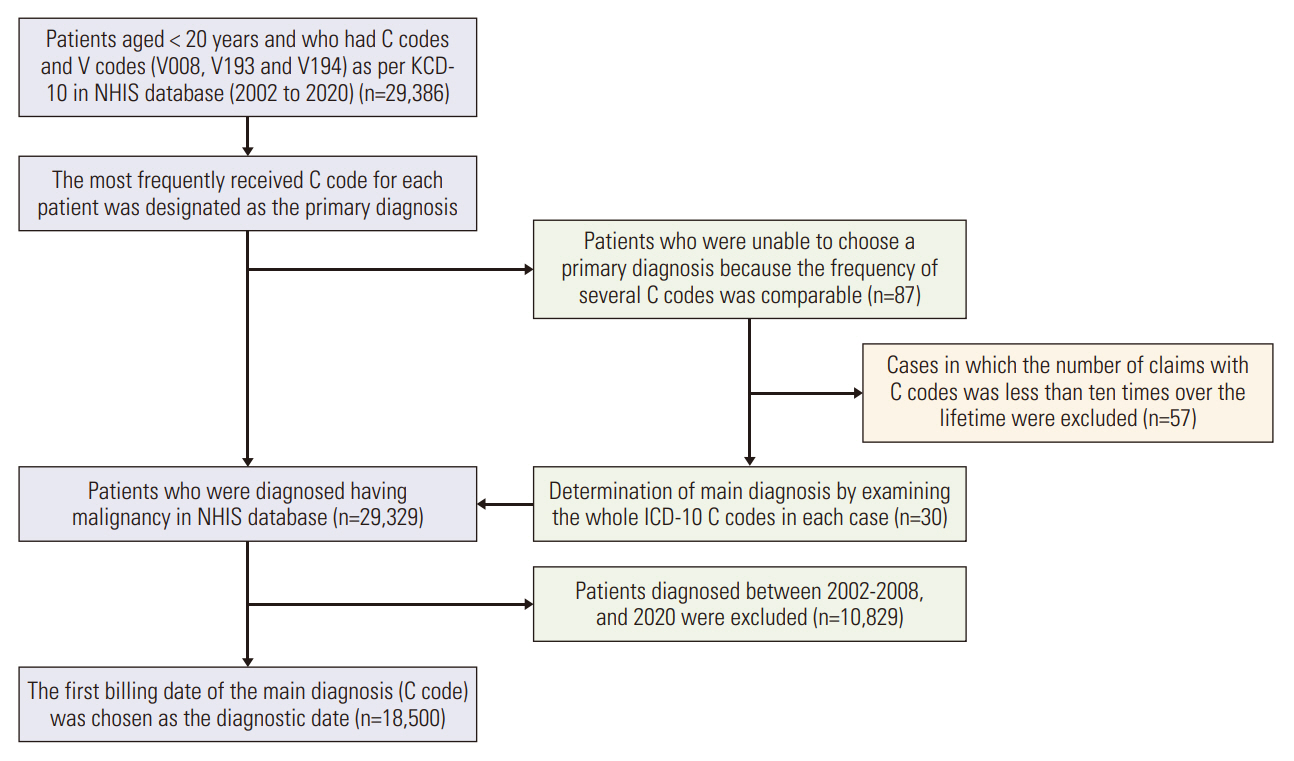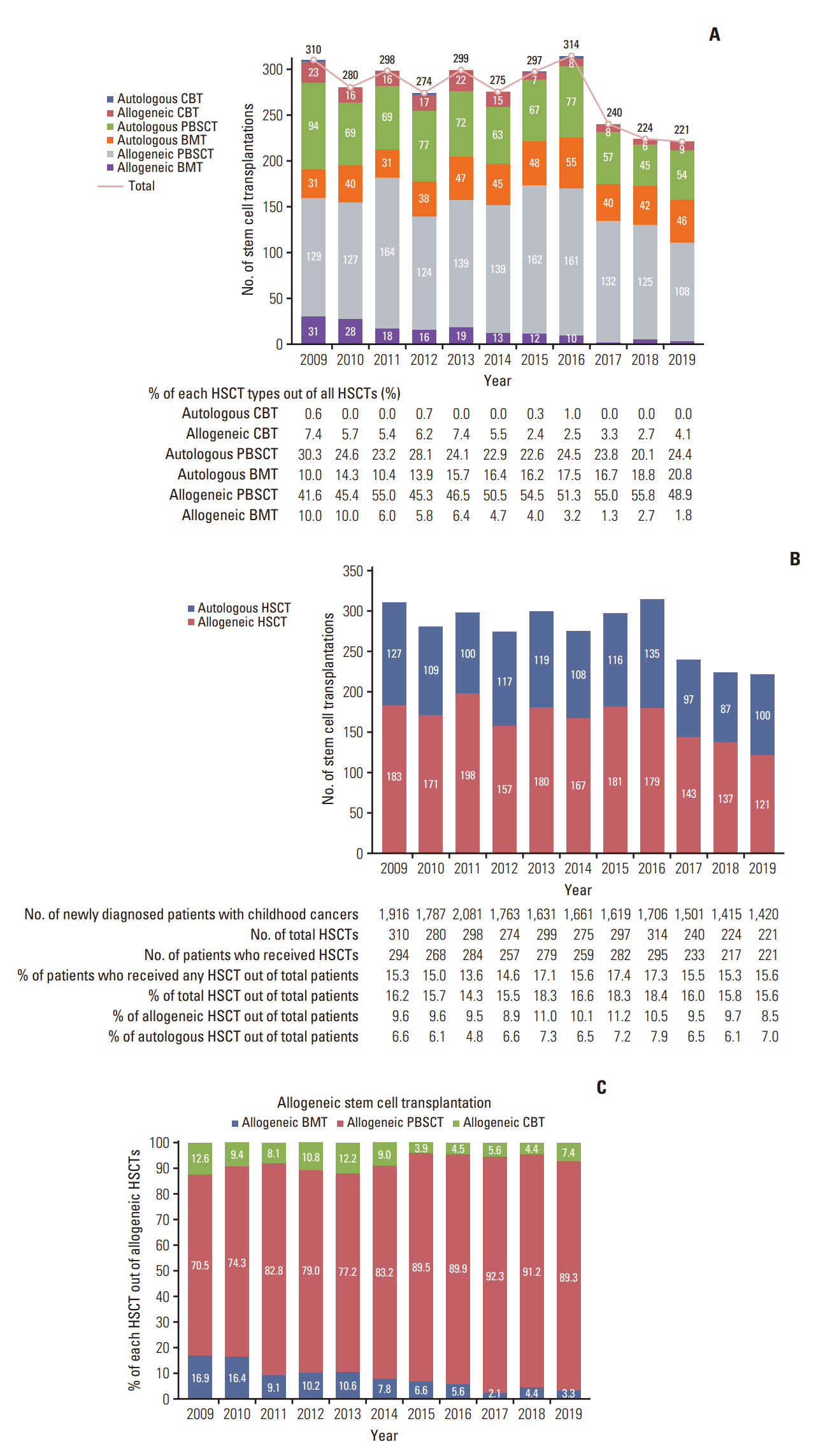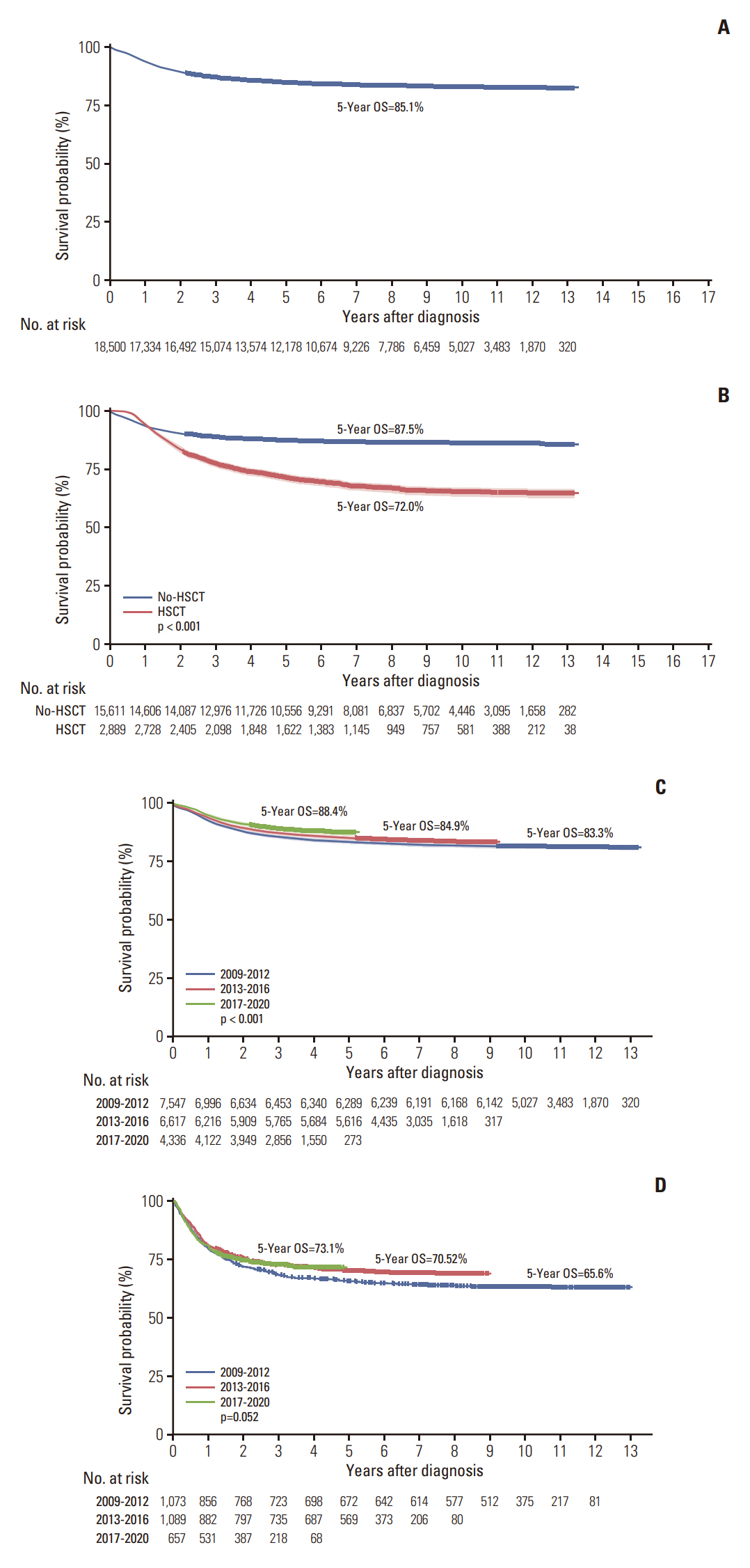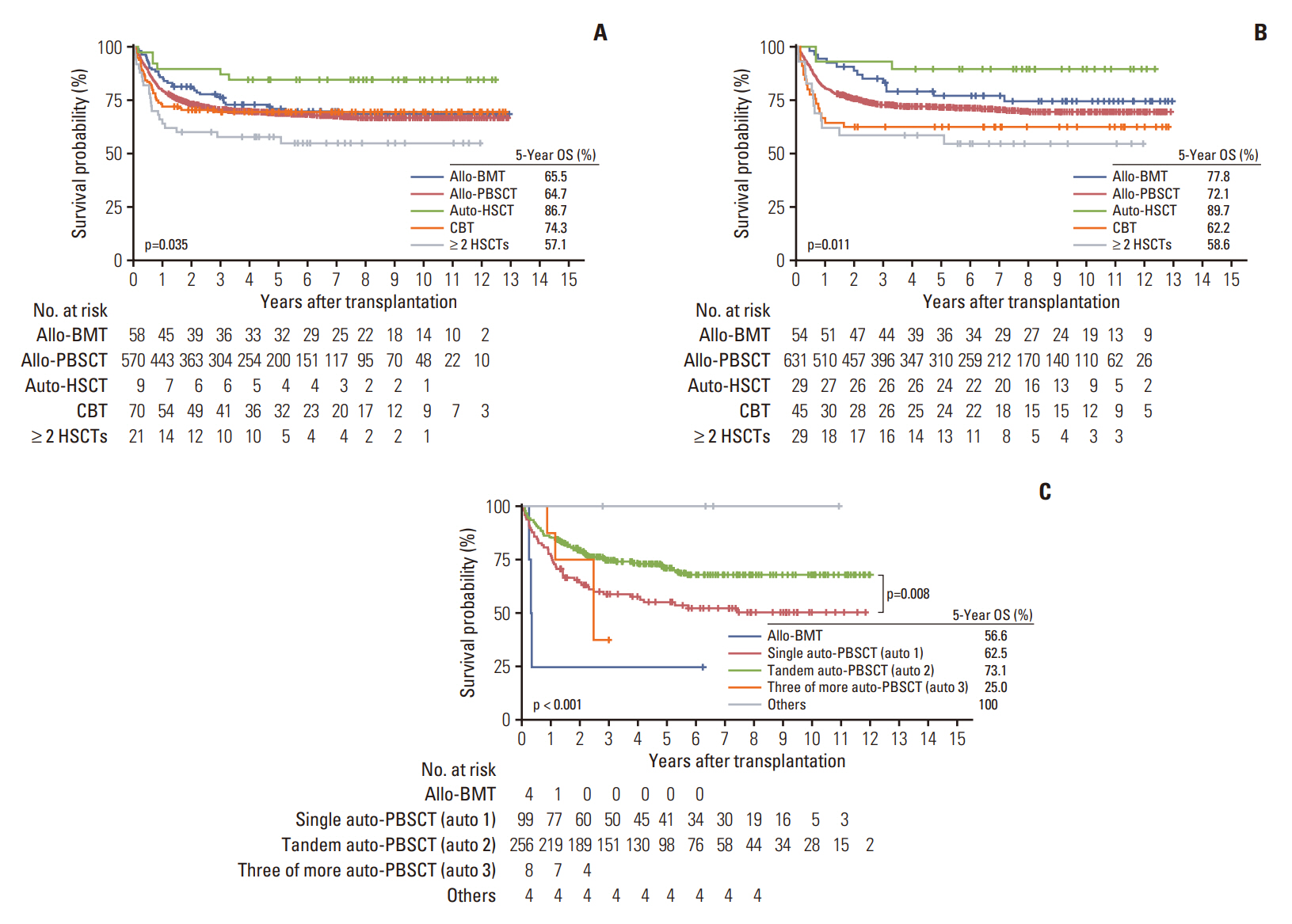Cancer Res Treat.
2024 Jan;56(1):294-304. 10.4143/crt.2023.598.
Ten-Year Trends of Hematopoietic Stem Cell Transplantation in Korean Pediatric Cancer from the National Health Insurance Claims Data
- Affiliations
-
- 1Department of Pediatrics, Asan Medical Center, University of Ulsan College of Medicine, Seoul, Korea
- 2Department of Clinical Epidemiology and Biostatistics, Asan Medical Center, University of Ulsan College of Medicine, Seoul, Korea
- 3Department of Pediatrics, Chosun University College of Medicine, Gwangju, Korea
- KMID: 2550344
- DOI: http://doi.org/10.4143/crt.2023.598
Abstract
- Purpose
We aimed to determine the current application and survival trends of hematopoietic stem cell transplantation (HSCT) among Korean children and adolescents with cancer.
Materials and Methods
Data of patients aged < 20 years with KCD-10 (Korean Classifications of Diseases, 10th revision) C codes and specific designation codes were collected from the National Health Insurance Service database. Thirty claim codes for HSCT were included, and data from 2009 to 2019 were analyzed.
Results
The operational definition of pediatric cancer yielded an annual average of 2,000, with annual cases decreasing. In 2019, 221 HSCTs were performed, a decrease from the ten-year average of 276. Allografts outnumbered autografts with a ratio of 1.5:1. The source of allograft was bone marrow in 15% of patients in 2009; however, it substantially decreased to 3.3% in 2019. Furthermore, 70.5% of allogeneic HSCT used peripheral blood stem cell (PBSC) grafts, which increased to 89.3% by 2015. Cord blood utilization markedly decreased to 2.7% in 2018. The 5-year overall survival (OS) rate of all patients was 85.1%. Overall mortality decreased among patients who underwent recent HSCT, and they exhibited a higher 5-year OS rate.
Conclusion
In Korea, the number of pediatric patients with cancer is declining; however, the ratio of transplants to all patients remains constant. Patients who recently underwent transplantation showed better survival rates, possibly due to HSCT optimization. Korea showed a substantially greater PBSC utilization in pediatric HSCT. An in-depth examination encompassing donor relations and cause of death with a prospective registry is required in future studies.
Keyword
Figure
Reference
-
References
1. Snowden JA, Sanchez-Ortega I, Corbacioglu S, Basak GW, Chabannon C, de la Camara R, et al. Indications for haematopoietic cell transplantation for haematological diseases, solid tumours and immune disorders: current practice in Europe, 2022. Bone Marrow Transplant. 2022; 57:1217–39.2. Calvo C, Ronceray L, Dhedin N, Buechner J, Troeger A, Dalle JH. Haematopoietic stem cell transplantation in adolescents and young adults with acute lymphoblastic leukaemia: special considerations and challenges. Front Pediatr. 2021; 9:796426.3. Lee JW. Haploidentical family donor transplantation for pediatric hematologic malignancies. Clin Pediatr Hematol Oncol. 2021; 28:67–74.4. Im HJ, Koh KN, Seo JJ. Recent advances in haploidentical hematopoietic stem cell transplantation using ex vivo T cell-depleted graft in children and adolescents. Blood Res. 2016; 51:8–16.5. Jeong DC, Kang HJ, Koo HH, Kook H, Kim SY, Kim SK, et al. Current status of hematopoietic stem cell transplantation in Korean children. Korean J Hematol. 2006; 41:235–42.6. Matthay KK, Villablanca JG, Seeger RC, Stram DO, Harris RE, Ramsay NK, et al. Treatment of high-risk neuroblastoma with intensive chemotherapy, radiotherapy, autologous bone marrow transplantation, and 13-cis-retinoic acid. Children’s Cancer Group. N Engl J Med. 1999; 341:1165–73.7. Sung KW, Ahn HS, Cho B, Choi YM, Chung NG, Hwang TJ, et al. Efficacy of tandem high-dose chemotherapy and autologous stem cell rescue in patients over 1 year of age with stage 4 neuroblastoma: the Korean Society of Pediatric Hematology-Oncology experience over 6 years (2000-2005). J Korean Med Sci. 2010; 25:691–7.8. Kim H. Pediatric cancer research using healthcare big data. Clin Pediatr Hematol Oncol. 2022; 29:1–11.9. Chung H, Kim SY, Kim HS. Clinical research from a health insurance database: practice and perspective. Korean J Med. 2019; 463–70.10. Lee JW, Kim CC. The activity of hematopoietic stem cell transplantation in Korea. Bone Marrow Transplant. 2008; 42 Suppl 1:S92–5.11. Park HJ, Moon EK, Yoon JY, Oh CM, Jung KW, Park BK, et al. Incidence and survival of childhood cancer in Korea. Cancer Res Treat. 2016; 48:869–82.12. Suh JK, Koh KN, Min SY, Kim YS, Kim H, Im HJ, et al. Feasibility and effectiveness of treatment strategy of tandem high-dose chemotherapy and autologous stem cell transplantation in combination with (131) I-MIBG therapy for high-risk neuroblastoma. Pediatr Transplant. 2020; 24:e13658.13. Park JE, Kang J, Yoo KH, Sung KW, Koo HH, Lim DH, et al. Efficacy of high-dose chemotherapy and autologous stem cell transplantation in patients with relapsed medulloblastoma: a report on the Korean Society for Pediatric Neuro-Oncology (KSPNO)-S-053 study. J Korean Med Sci. 2010; 25:1160–6.14. Sung KW, Lim DH, Son MH, Lee SH, Yoo KH, Koo HH, et al. Reduced-dose craniospinal radiotherapy followed by tandem high-dose chemotherapy and autologous stem cell transplantation in patients with high-risk medulloblastoma. Neuro Oncol. 2013; 15:352–9.15. D’Souza A, Fretham C, Lee SJ, Arora M, Brunner J, Chhabra S, et al. Current use of and trends in hematopoietic cell transplantation in the United States. Biol Blood Marrow Transplant. 2020; 26:e177–82.16. Auletta JJ, Kou J, Chen M, Shaw BE. Current use and outcome of hematopoietic stem cell transplantation: CIBMTR US summary slides. Milwaukee, WI: Center for International Blood and Marrow Transplant Research;2021.17. Korean Blood & Marrow Transplantation Nursing Society. Annual number of BMT in Korea [Internet]. Seoul: Korean Blood & Marrow Transplantation Nursing Society;2022. [cited 2023 Sep 7]. Available from: http://www.bmtnurse.org/default/mp6/mp6_sub6.php?sub=01.18. Hopman RK, DiPersio JF. Advances in stem cell mobilization. Blood Rev. 2014; 28:31–40.19. Shimosato Y, Tanoshima R, Tsujimoto SI, Takeuchi M, Shiba N, Kobayashi T, et al. Allogeneic bone marrow transplantation versus peripheral blood stem cell transplantation for hematologic malignancies in children: a systematic review and meta-analysis. Biol Blood Marrow Transplant. 2020; 26:88–93.20. Svenberg P, Remberger M, Uzunel M, Mattsson J, Gustafsson B, Fjaertoft G, et al. Improved overall survival for pediatric patients undergoing allogeneic hematopoietic stem cell transplantation: a comparison of the last two decades. Pediatr Transplant. 2016; 20:667–74.21. Brissot E, Rialland F, Cahu X, Strullu M, Corradini N, Thomas C, et al. Improvement of overall survival after allogeneic hematopoietic stem cell transplantation for children and adolescents: a three-decade experience of a single institution. Bone Marrow Transplant. 2016; 51:267–72.
- Full Text Links
- Actions
-
Cited
- CITED
-
- Close
- Share
- Similar articles
-
- Hematopoietic Stem Cell Transplantation in Inborn Error of Metabolism
- Opening the era of in vivo xenotransplantation model for hematopoietic stem cell transplantation
- Hematopoietic Stem Cell Transplantation
- Sensitivity of Medical Insurance Claims Data Using Population-based Cancer Registry Data
- Educational Needs of Families of Children Undergoing Hematopoietic Stem Cell Transplantation





